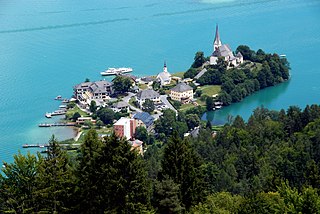
The Duchy of Carinthia was a duchy located in southern Austria and parts of northern Slovenia. It was separated from the Duchy of Bavaria in 976, and was the first newly created Imperial State after the original German stem duchies.

Carantania, also known as Carentania, was a Slavic principality that emerged in the second half of the 7th century, in the territory of present-day southern Austria and north-eastern Slovenia. It was the predecessor of the March of Carinthia, created within the Carolingian Empire in 889.

Carinthia is the southernmost and least densely populated Austrian state, in the Eastern Alps, and is noted for its mountains and lakes. The main language is German. Its regional dialects belong to the Southern Bavarian group. Carinthian Slovene dialects, forms of a South Slavic language that predominated in the southeastern part of the region up to the first half of the 20th century, are now spoken by a small minority in the area.

Carantanians were a Slavic people of the Early Middle Ages, living in the principality of Carantania, later known as Carinthia, which covered present-day southern Austria and parts of Slovenia. They are considered ancestors of modern Slovenes, particularly Carinthian Slovenes.

The Prince's Stone is the reversed base of an ancient Ionic column that played an important role in the ceremony surrounding the installation of the princes of Carantania in the Early Middle Ages. After the incorporation into the Frankish Empire, the procedure, held in Slovene, was continued as the first part of the coronation of the Dukes of Carinthia. It was followed by a mass at Maria Saal cathedral and the installation at the Duke's chair, where he swore an oath in German and received the homage of the estates.

Hochosterwitz Castle is a castle in Austria, considered one of Austria's most impressive medieval castles. It is on a 172-metre (564 ft) high dolomite rock near Sankt Georgen am Längsee, east of the town of Sankt Veit an der Glan in Carinthia. The rock castle is one of the state's landmarks and a major tourist attraction.
Bezirk Klagenfurt-Land is a district of the state of Carinthia in Austria.

St. Veit an der Glan is a town in the Austrian state of Carinthia, the administrative centre of the St. Veit an der Glan District. It was the historic Carinthian capital until 1518. The famous chef Wolfgang Puck was born there in 1949.
Magdalensberg is a market town in the district of Klagenfurt-Land in Carinthia in Austria.

Maria Wörth is a municipality in the district of Klagenfurt-Land in the Austrian state of Carinthia. The centre of the resort town is situated on a peninsula at the southern shore of the Wörthersee. In the east, the municipal area borders the Carinthian capital Klagenfurt. The municipality consists of the two Katastralgemeinden Maria Wörth and Reifnitz.

Moosburg is a market town in the Klagenfurt-Land district in the Austrian state of Carinthia.

St. Georgen am Längsee is a municipality in the district of St. Veit an der Glan in Carinthia, Austria.

Arnoldstein is a market town in the district of Villach-Land in the Austrian state of Carinthia.

Griffen is a market town in the district of Völkermarkt in the Austrian state of Carinthia.

The Duke's Chair, also known as the Duke's Seat, is a medieval stone seat dating from the ninth century and located at the Zollfeld plain near Maria Saal, north of Klagenfurt in the Austrian state of Carinthia.

Zollfeld is a slightly ascending plain in Carinthia, Austria with interspersed small woods, hills, and swamps. It is one of the oldest cultural landscapes in the East Alpine region.

Modestus, called the Apostle of Carinthia or Apostle of Carantania, was most probably an Irish monk and the evangeliser of the Carantanians, an Alpine Slavic people settling in the south of present-day Austria and north-eastern Slovenia, who were among the ancestors of present-day Slovenes.

Claudium Virunum was a Roman city in the province of Noricum, on today's Zollfeld in the Austrian State of Carinthia. Virunum may also have been the name of the older Celtic-Roman settlement on the hilltop of Magdalensberg nearby. Virunum (Virunensis) is today a Catholic titular see.
Boruth, also Borut or Borouth, was the first documented Slavic prince (Knyaz) of Carantania, ruling from about 740 until his death. He was one of the few pagan leaders of the Carantanians to convert to Christianity.

The Pilgrimage Church of the Assumption of Mary, also called Maria Saal Cathedral, is a Catholic church in the town of Maria Saal in Carinthia, Austria. Though not the see of a bishop, the church building is a renowned monument of Late Gothic architecture and one of Carinthia's most visited landmarks.






















